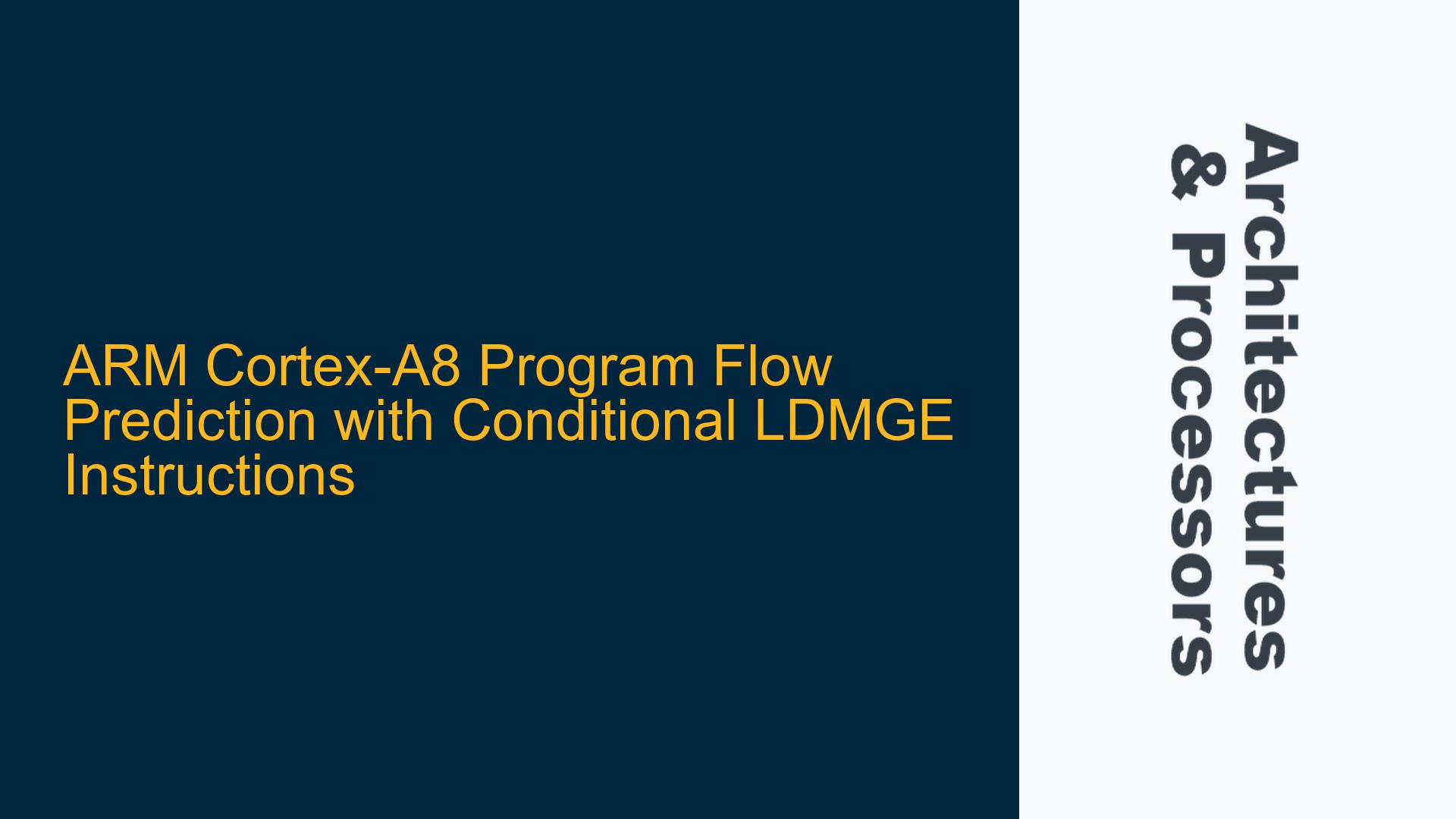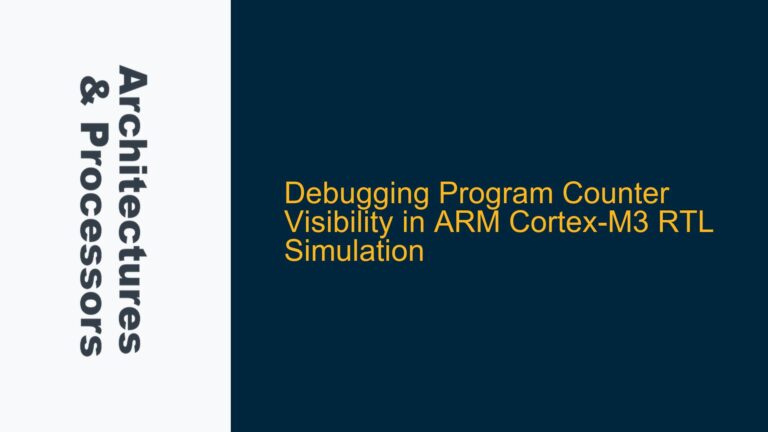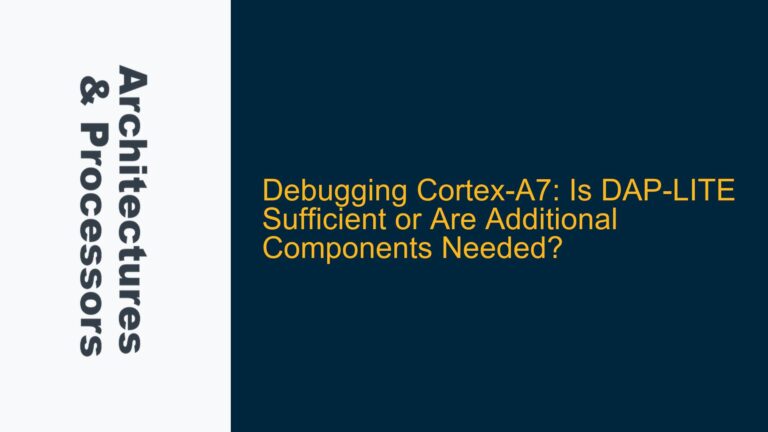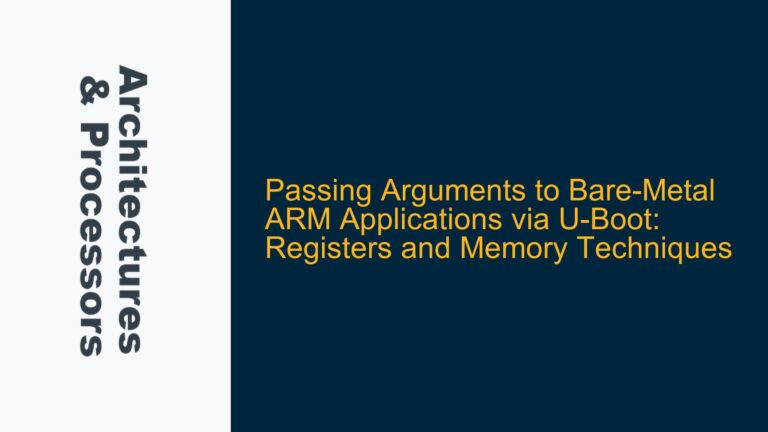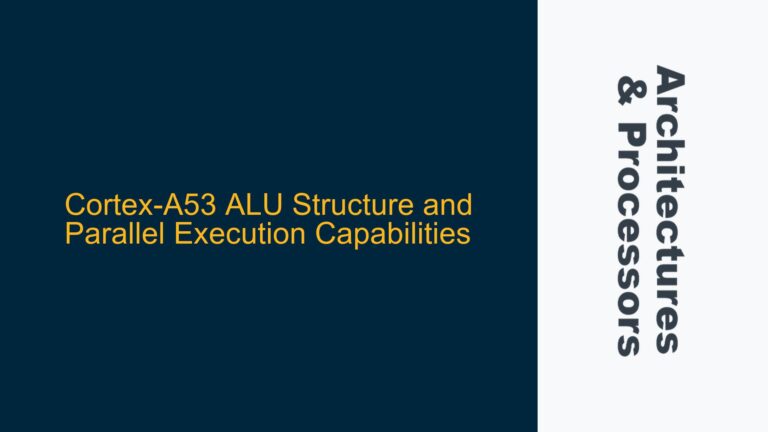ARM Cortex-A8 Program Flow Prediction Behavior with Conditional LDMGE Instructions
The ARM Cortex-A8 processor is designed to optimize program execution through advanced program flow prediction mechanisms. One such mechanism involves predicting the outcome of load multiple (LDM) instructions, particularly when the program counter (PC) is included in the register list. However, the behavior of program flow prediction becomes less straightforward when conditional instructions, such as LDMGE (Load Multiple if Greater Than or Equal), are involved. The Cortex-A8’s ability to predict the flow of conditional LDM instructions depends on several factors, including the history of condition evaluation and the speculative execution capabilities of the processor.
In the provided code sequence, the LDMGE instruction is conditionally executed based on the result of a preceding compare (CMP) instruction. The Cortex-A8’s program flow prediction logic must determine whether the condition (GE) will be met and whether the LDMGE instruction will modify the program counter (PC). If the condition is not met, the processor should continue executing the subsequent instructions without branching. However, if the condition is met, the processor must predict the target address of the LDMGE instruction and begin fetching instructions from that address speculatively.
The Cortex-A8’s branch prediction unit (BPU) is responsible for making these predictions. The BPU uses a combination of static and dynamic prediction techniques. Static prediction relies on the instruction type and its encoding, while dynamic prediction uses historical data about the behavior of specific branches. For conditional LDM instructions, the BPU must evaluate the likelihood of the condition being met based on past executions of the same instruction or similar patterns.
In the given example, the LDMGE instruction is executed multiple times with the condition not being met (i.e., the value of index is lower than array_size). After several iterations, the BPU may learn that the condition is unlikely to be met and begin predicting that the LDMGE instruction will not modify the PC. This allows the processor to speculatively execute the instructions following the LDMGE instruction, improving performance by reducing pipeline stalls.
However, this speculative execution introduces the risk of incorrect predictions. If the condition is unexpectedly met (e.g., the value of index becomes greater than or equal to array_size), the processor must discard the speculatively executed instructions and fetch the correct target address from the LDMGE instruction. This process, known as a pipeline flush, incurs a performance penalty.
Conditional Execution History and Speculative Execution Challenges
The Cortex-A8’s ability to predict the outcome of conditional LDMGE instructions depends heavily on the history of condition evaluation. The processor maintains a record of past condition outcomes for specific instructions, which it uses to inform future predictions. This historical data is stored in the branch target buffer (BTB), a cache-like structure that maps instruction addresses to their predicted outcomes and target addresses.
For conditional LDMGE instructions, the BTB tracks whether the condition was met or not met in previous executions. If the condition has consistently not been met over multiple iterations, the BTB will predict that the condition will continue to not be met in future executions. Conversely, if the condition has been met frequently, the BTB will predict that the condition is likely to be met again.
However, the BTB’s predictions are not infallible. Changes in program behavior, such as a sudden shift in the value of index, can lead to incorrect predictions. For example, if the value of index has been consistently lower than array_size for several iterations, the BTB will predict that the LDMGE condition will not be met. If the value of index then becomes greater than or equal to array_size, the BTB’s prediction will be incorrect, resulting in a pipeline flush and a performance penalty.
Another challenge arises from the speculative execution of instructions following the LDMGE instruction. When the BPU predicts that the condition will not be met, it allows the processor to speculatively execute the subsequent instructions. However, these speculatively executed instructions may have side effects, such as modifying memory or registers, that must be undone if the prediction is incorrect. The Cortex-A8 handles this by buffering the results of speculative execution and committing them only if the prediction is correct. If the prediction is incorrect, the buffered results are discarded, and the processor resumes execution from the correct target address.
The speculative execution of conditional LDMGE instructions also interacts with the processor’s cache and memory subsystem. If the LDMGE instruction modifies the PC and branches to a new address, the processor must fetch instructions from that address. If the target address is not in the instruction cache, the processor will experience a cache miss, further increasing the latency of the branch. To mitigate this, the Cortex-A8 employs prefetching techniques to load instructions from the predicted target address into the cache before they are needed.
Optimizing Program Flow Prediction for Conditional LDMGE Instructions
To optimize program flow prediction for conditional LDMGE instructions, developers can take several steps to improve the accuracy of the BPU’s predictions and reduce the performance impact of incorrect predictions. One approach is to minimize the variability of the condition being evaluated. If the condition is highly variable, the BPU will struggle to make accurate predictions, leading to frequent pipeline flushes and performance degradation. By reducing the variability of the condition, developers can improve the BPU’s prediction accuracy and reduce the likelihood of incorrect predictions.
Another approach is to use profiling tools to analyze the behavior of conditional LDMGE instructions in the target application. Profiling can reveal patterns in the evaluation of the condition, such as whether it is consistently met or not met, and how often it changes. This information can be used to guide code optimization, such as restructuring the code to reduce the frequency of conditional branches or replacing conditional LDMGE instructions with unconditional branches where possible.
Developers can also use compiler optimizations to improve the performance of conditional LDMGE instructions. Modern compilers, such as GCC and Clang, offer a range of optimizations that can improve branch prediction accuracy and reduce the overhead of speculative execution. For example, the compiler can reorder instructions to reduce the likelihood of pipeline stalls or insert prefetch instructions to load the target address into the cache before it is needed.
In some cases, it may be beneficial to use hardware features of the Cortex-A8 to improve program flow prediction. For example, the Cortex-A8 supports branch prediction hints, which allow developers to provide additional information to the BPU about the likely outcome of a branch. These hints can be used to improve the accuracy of predictions for conditional LDMGE instructions, particularly in cases where the condition is highly predictable.
Finally, developers should be aware of the potential impact of speculative execution on system behavior. Speculative execution can lead to unintended side effects, such as memory accesses or register modifications, that must be carefully managed to ensure correct program behavior. By understanding the interaction between speculative execution and program flow prediction, developers can write more efficient and reliable code for the Cortex-A8 processor.
In conclusion, the ARM Cortex-A8’s program flow prediction capabilities provide significant performance benefits, particularly for conditional LDMGE instructions. However, the accuracy of these predictions depends on the history of condition evaluation and the behavior of the target application. By understanding the challenges of speculative execution and employing optimization techniques, developers can maximize the performance of their code on the Cortex-A8 processor.
